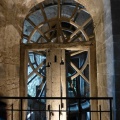TUG 2013 – Day 2
 Here now the recollections from the second day of the TUG 2013 in Tokyo. For the first see TUG 2013 – Day 1
Here now the recollections from the second day of the TUG 2013 in Tokyo. For the first see TUG 2013 – Day 1
The second day brought a big part on graphics, two excellent tutorials on Japanese typefaces and text layout, a hands-on tutorial on actually typing Japanese on computers, as well as a few other talks.
Morning
The second day started with a series on talks on how to use variaous graphics packages:
- Masataka Kaneko – Making math textbooks and materials with TeX+KETpic+hyperlink (abstract, slides)
- Alan Wetmore – Wind roses for TeX documents (abstract, slides)
- Boris Veytsman & Leila Akhmadeyeva – Plots in LaTeX: Gnuplot, Octave, make (abstract, slides)
Myself being a hard-core TikZ-user, I still enjoy seeing other graphics system. In the case of TeX+KETpic+hyperlink, I was surprised what can be done. What would have been interesting to me is to see more actual code, as I want to know whether it is easy to write that code. Alan’s talk presented us some beautifully designed wind-roses. I really appreciate these kinds of talks, since we always have lots of technical talks, some artistic design reminds us that we should go forth and create beautiful printing matter. Last in the first session was Boris and Leila on how to automatize plot generation using make and GNUplot and Octave.
Before lunch we had one tutorial, actually one I was eagerly awaiting:
- Yumi Takata – Japanese Typeface Design—Similarities and Differences from Western Typeface Design (abstract, slides)
This tutorial started with an excellent introduction to Japanese writing styles and its history, slightly overlapping the tutorial of the first day. After that Yumi Takata got into the specifics of type design and how to create the huge amount of glyphs necessary. In the last part she gave a glance at the difficulties of encodings in use. Although I personally would have liked to hear more about the actual design process and technical procedure, the tutorial was one of the highlights for me. All the pieces were very well presented and explained. Thanks!
Afternoon
The first session in the afternoon brought two talks:
- Aleksandra Hankus & Zofia Walczak – LaTeX and graphics (abstract)
- Frank Mittelbach – LaTeX3: Using the layers (abstract, slides)
Our guests from Poland were very enthusiastic in presenting the history and different options of using graphics in LaTeX. While there were a few omissions, they did a very good job in reminding us on what else there is besides TikZ. But maybe it was only me who was reminded. Frank spoke about LaTeX3 and how it is structured – or how it will be structured. While the future of LaTeX3 is not clear to me, even after that talk, I see the `use-now’ packages in ever-growing use in LaTeX2e, so I am confident that we will see further developments.
After a short break (btw, I have to mention, the coffee breaks were excellent, too. The variety of snacks, cakes, crackers, strange tube-shaped sweets, fruit gelees, and what else I forgot, really drew the attention of at least all the foreign attendees! Thanks to the team!) another set of two tutorials:
- Masafumi Yabe – Japanese Text Layout — Basic Issues (abstract, slides)
- Yusuke Kuroki – Some notes on Japanese TeXt processing (slides)
Masafumi Yabe is a long-term contributer to several standards of Japanese text layout, and thus the perfect source of detailed information. Layout of the page in a typical Japanese book, details about spacing between Japanese and non-Japanese glyphs, vertical versus horizontal typesetting – you name it. All the important informations without loosing oneself into the details. I rich source of information. After that, Yusuke Kuroki gave a hands-on tutorial on how to actually input Japanese text. Supported by fast-finger Moe Masuko, they explained how to input text on smart-phones as well as computers in a variety of ways. He also gave some warnings concerning implementations and spacing, as well as the current state of TeX engines.
The last session brought two talks, one on TeXShop and one on the TeX Live Manager:
- Yusuke Terada – Development of TeXShop — the past and the future (abstract, slides)
- Norbert Preining – TeX Live Manager’s hidden gems: User mode and multiple repository support (abstract, slides)
First, Yusuke Terada gave a good overview on the current state of TeXShop, one of the very user-friendly TeX editors on Mac, and how over the years thanks to him and some other Japanese developers the capabilities with respect to Japanese type setting have been improved. Very funny were his experiments with his own name, containing a special kanji, that often gets garbled up during operations. I guess for many in the audience seeing these examples finally made them understand how nasty beasts are lying down there in the implementations, and often not even companies like Apple manage them properly. Unfortunately one talk had to be cancelled, the one on TeX Live for Android, since the presented could not attend the conference. What a pity, many very looking forward to that talk. The last one for the day was my own talk on TeX Live Manager’s rare gems, the user mode and multiple repositories. While I have talked already last year about multiple repositories, a few more features have been added over the year to tlmgr. And the user mode, although not often used, needed some explanation, too.
Evening
After the successful second day, not surprisingly, a few people spent the rest of the evening in a nice Okonomiyaki place – little upmarket and posh, but also excellent food. And Didier finally got his most-beloved Japanese food, a nice Kyoto-style okonomiyaki, not to forget the beer.
… to be continued soon … see TUG 2013 – Day 3

